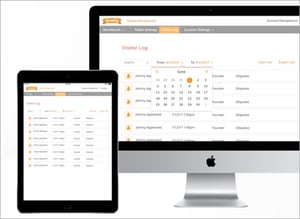Visitors are an essential part of any organization achieving its mission and goals. Even workplaces that "don't receive visitors" receive plenty of them. Consider the HVAC service person, the pizza delivery guy, the significant other coming for lunch, and the random person dropping in to pick up a job application. Often, we recognize that visitors are some of our most important people: the manager from the main office, the high-priority client, the guests coming for a special promotional event.
Every person, from the corporate bigwig to the parcel delivery service, must be greeted and have their business attended to. A visitor management system will make this process smooth and secure for both the visitor and the organization.
What Is a Visitor Management System?
Visitor management is the process by which all visitors to an organization are greeted, identified, and moved along so they can complete their tasks. Some organizations are very informal and have no standardized system, while others utilized dedicated receptionists and still, others use electronic visitor management systems to streamline the process.
In most electronic visitor management systems, guests check in at a kiosk or other workstation. The software logs the visit:
- Date
- Check-in time
- Name
- Phone number, email address and other pertinent contact information as requested
- Reason for visiting
- Person being met
- Check-out time, if required
The software may also contain other features, such as the ability to automatically notify the guest’s host, send emails to the guest, open up forms for e-signature purposes and more.
Here are the five biggest benefits to both visitors and host companies of utilizing a visitor sign-in app:
Saving Time, Gaining Productivity
Better Data Collection
Visitor Privacy
Organizational Security
A Professional Image

Saving Time, Gaining Productivity

One of the first, and largest, benefits of using an electronic visitor management system is that of saving time, and thus, improving productivity.
In some flex workspaces, open floor plan offices, and other informal working locations, there is no formal receptionist. Organizations have chosen not to hire someone for the sole purpose of greeting those who come through the door. This can leave visitors in a bind.
When a visitor enters a building, the first thought on their mind is, “Where am I supposed to go, and what am I supposed to do?” In such a workspace, this is likely the scenario that plays out:
- The visitor approaches the first person they see. This unlucky soul either was assigned to a desk near the door or happened to sit there. Thus, their work gets interrupted as they assist the visitor.
- If the visitor is lucky, the first person they see will know exactly where their host is and either walks them to the host or call the host to have them come to meet their guest. Either way, the employee is using their work time to assist the guest.
- If the visitor isn’t so lucky, the first person they see may not know their host's name or their host’s location. This employee then calls to the neighboring employees, or places multiple phone calls, wasting not only their own time but the time of others.
- In the worst-case scenario, the host can’t be located and nearly everyone in the office has been interrupted.
A well-marked visitor check-in kiosk makes the question of what a visitor is supposed to do completely moot. The obvious answer is to walk to the kiosk and start the check-in process. The system asks the guest to take a seat while it automatically contacts the host via their communication preferences.
Even in organizations where a receptionist is available, it is highly likely the receptionist has other duties to attend to aside from assisting guests. Filling out a registration form for the guest, placing phone calls to hosts, or possibly walking the guest to the host is not always a valuable use of time. If a guest can fill out the check-in form themselves, it allows the receptionist to answer the phone, or type up some notes during this same time.
In the very busiest of offices, multiple check-in kiosks can assist multiple guests at once, eliminating wait times. This also frees up employees to help with the questions and tasks most in need of being addressed.
When push comes to shove, paying for a machine for rote tasks like visitor management is much more cost-effective than paying one or more dedicated employees.
Better Data Collection
 Have you been keeping paper visitor logs? If so, take a few moments to flip through the last few pages. Can you read the handwriting? Are your guests bothering to fill out all the slots, like check-in/out times and their email addresses?
Have you been keeping paper visitor logs? If so, take a few moments to flip through the last few pages. Can you read the handwriting? Are your guests bothering to fill out all the slots, like check-in/out times and their email addresses?
What do you do with the paper logs after the pages have been filled? Some common options:
- Most Likely: File them in the circular file, i.e. the trash.
- Also Likely: File them away in an actual file cabinet or box, never to be seen again until an office purge, at which time they’ll end up in the shredder.
- Least Likely: Have someone enter all the information into a log or Contact Relationship Management (CRM) system. Only to never be looked at again. Not a great use of valuable employee time.
The truly sad fact is that visitor logs contain valuable data, but if that data is being collected on paper, it usually goes to waste.
On the other hand, electronic visitor management systems make collecting valuable data much, much simpler. They do so in a number of ways.
- Required Fields: Visitor management systems can designate fields as required. No longer can guests leave the most important information blank.
- Legible/Accurate: Since guests are not hand-writing their information, there are no questions at all about legibility. While it is always possible that a guest will mistype their own contact information, it is more likely that a receptionist will enter incorrect information when retyping what they hear, or retyping off a paper log. A guest is more apt to catch a misspelled name or an incorrect phone number when they type it themselves.
- Form Inclusion: Computers have the ability to include attachments. A human receptionist might forget to have a visitor fill out a non-disclosure agreement or sign a waiver, but a computer never will. An e-signature app will collect these signatures for you, and file them away until they are needed.
Automatic Customer Relations: A great digital visitor management system can be set up to automatically transfer visitor data into your CRM. Once in place, this valuable information allows you to follow up with guests in whatever way is suitable. You can make a great impression by sending thank you notes to job candidates, special offers to potential clients, and information to vendors.
Visitor Privacy: Digital > Paper

Your visitor’s privacy is important. While people share their information in a multitude of ways, people generally prefer to decide for themselves with whom they share their information. A visitor sign-in app collects important information in a secure way.
Privacy is not very well maintained if you are using a paper visitor log. Every guest who arrives can see who came before them. Salespeople and job candidates can see if their competitors have been through. Unless the logbook is under a constant, watchful eye, anyone can flip through the pages and collect as much information as they choose. People fishing for email addresses or phone numbers could snap photos using their smartphones.
Unlike a paper log, a digital sign-in app keeps this information secure. Guests can’t see who signed in before; they only see their own information on the screen during their sign-in process. Once the final button of the sign-in process has been clicked, the information is quickly and securely filed away in the database.
Organizational Security
In today’s world, security is an increasing concern for organizations of all sizes and types.
Collecting the information of all those who visit your organization can be vitally necessary. Security needs vary among different organizations, but a sign-in system carries a number of security benefits.
- Meeting legal requirements: Some organizations are required by various laws to keep a record of every person who has been on site. Digital databases with visitor sign-in help meet these regulations quickly and efficiently.
- Crime deterrent: Requiring all guests to sign in can be a deterrent for those who might have the intent to commit a crime. If the person enters the building with the intent to do harm, having to sign in might be enough to make them think twice, turn around and walk away. Those who face unanticipated temptation, like seeing a laptop or tablet sitting on an unattended desk, may remember that they signed in and won’t bother.
- Investigative tool: On the other hand, someone who commits a crime on the spur of the moment – like snagging that laptop off the desk – may forget about having signed in. Given that the digital sign-in saves date and time of check-in and possibly also check-out, the data will be useful for the investigation. If it is clear the crime was committed during a set period of time, the records of who was in the building at that time can help narrow down the pool of suspects. Some systems may even take photos of all visitors, which can be incredibly useful for visually identifying suspects, especially if your organization has security cameras in place.
- Identifying visitors: Some systems have the ability to print visitor identification badges. The security benefits of badges are fairly obvious. Depending on your company policy, visitors may not be allowed in the building unattended, or will be restricted from certain areas. The visual indicator that someone is a visitor can help employees keep an eye out for people who aren’t where they are supposed to be.
- Keeping everyone safe: Having records of check-ins and check-outs of all visitors allows security personnel to see if the building is empty before closing up for the night, or at the end of each shift. If a person seems not to have left the building in a timely manner, then a security guard can go looking for them. If they are up to no good – hiding away in a stairway with the intent to steal things after hours – they are more likely to be stopped before they can get started. On the other hand, if the visitor has fallen ill and fainted in an out-of-the-way place, like a bathroom stall, they’ll likely be found and help can be called. And if there is a true emergency, like a fire, the data stored in the cloud can help determine if everyone has evacuated safely.
A Professional Image
Last, but certainly not least, a digital sign-in app helps you present a professional image to your visitors.
- Modern: A digital kiosk presents a clean, up-to-date system to visitors. No messy paper log can show you have entered the modern era as an iPad receptionist can.
- Branded Messages: Your digital system can be branded with your colors, your products, and your message. Your visitors will be immersed in your brand from the moment they walk through the doors. A digital system can be a continuation of that, introducing them to even more of what you want them to see.
- Great First Impression: A harried receptionist – or no receptionist at all – can make a visitor wonder if your organization has its act together. A self-check-in kiosk shows that you’ve thought ahead and planned for visitors. It gives the impression that you are organized and professional.
Summary: Benefits That Make a Difference
With all the benefits a digital visitor management system has to offer, it is clear why so many organizations are giving them a try.
- Airports use self-check-in kiosks in order to let the employees handle the real challenges.
- Schools use visitor check-in systems for security purposes so they know exactly who is in the building with the students.
- Coworking locations use them to contact hosts in a fast, efficient manner when a formal receptionist doesn’t make sense.
- Businesses of all kinds, from manufacturing to sales, use them to ensure their guests are welcomed, are where they are supposed to be, and walk away with a great impression of the organization.
In the end, the goal of visitor management is to do exactly that: to help guests do what they are supposed to do and meet who they are supposed to meet as quickly, effectively, securely, and professionally as possible.